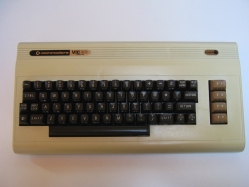
Autopsy:
from Wikipedia:
The VIC-20 (Germany: VC-20; Japan: VIC-1001) is an 8-bit home computer which was sold by Commodore Business Machines. The VIC-20 was announced in 1980, roughly three years after Commodore’s first personal computer, the PET. The VIC-20 was the first computer of any description to sell one million units.
The VIC-20 was intended to be more economical than the PET computer. It was equipped with only 5 kB of RAM (of this, only 3583 bytes were available to the BASIC programmer) and used the same MOS 6502 CPU as the PET. The VIC-20′s video chip, the MOS Technology VIC, was a general-purpose color video chip designed by Al Charpentier in 1977 and intended for use in inexpensive display terminals and game consoles, but Commodore could not find a market for the chip.
As the Apple II gained momentum with the advent of VisiCalc in 1979, Jack Tramiel wanted a product that would compete in the same segment, to be presented at the January 1980 CES. For this reason Chuck Peddle and Bill Seiler started to design a computer named TOI (The Other Intellect).
source: wikipedia
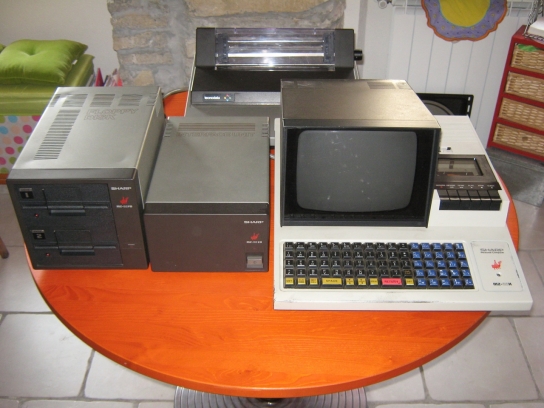
You can see the individual devices by clicking the link below.
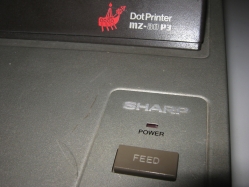
Autopsy:
I have removed two polyester capacitors (filter) before they explode.
This is a dot matrix printer produced by Sharp for Personal microcomputer System MZ-80 Series. The Sharp MZ-80 P3 must be connected to the Sharp MZ-80 I/O (Interface Unit) to be utilized. This printer has been built by Epson and later rebranded by Sharp.
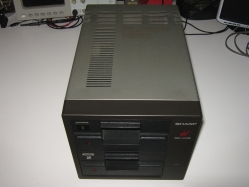
Autopsy:
I have removed two polyester capacitors (filter) before they explode.
Floppy Disk Drive for Personal microcomputer System MZ-80 Series. Each floppy disk can contain 143k of data for a total of 286K. The Floppy Disk Drive must be connected to the Sharp MZ-80 I/O (Interface Unit) to be utilized.
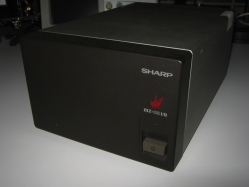
Autopsy:
I have removed two polyester capacitor (filter) that are exploded after a few seconds.
This is a I/O Extension device to connect bus-line signals being output from MZ-80K to peripheral units such as dot printer, floppy disk, colour display and so on.
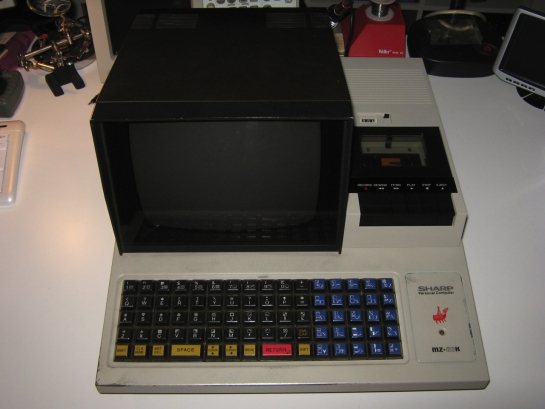
Autopsy:
from Wikipedia:
The Sharp MZ is a series of personal computers sold in Japan and Europe (particularly Germany and Great Britain) by Sharp beginning in 1978.
Although commonly believed to stand for “Microcomputer Z80″, the term MZ actually has its roots in the MZ-40K, a home computer kit produced by Sharp in 1978 which was based on Fujitsu’s 4-bit MB8843 processor and provided a simple hexadecimal keypad for input. This was soon followed by the MZ-80K, K2, C, and K2E, all of which were based on 8-bit LH0080A Sharp CPU (compatible to Zilog Z80A) with an alphanumeric keyboard.
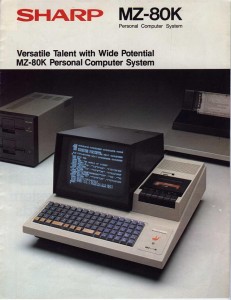 The Sharp MZ80K was one of the popular early consumer-level microcomputers, with an architecture based on the Zilog Z80 8-bit microprocessor. It was introduced into Europe in 1979. The machine had 48KB of RAM, 32KB of which was available for user programs (the actual figure was dependent on the memory configuration and the system languages being used).
The Sharp MZ80K was one of the popular early consumer-level microcomputers, with an architecture based on the Zilog Z80 8-bit microprocessor. It was introduced into Europe in 1979. The machine had 48KB of RAM, 32KB of which was available for user programs (the actual figure was dependent on the memory configuration and the system languages being used).
It could run a variety of high-level languages including BASIC, Pascal and FORTRAN, which had to be loaded into RAM before any programming could be undertaken. It could also be programmed directly in assembly code or machine code. The machine had an inbuilt monochrome display and a cassette tape drive. The display, keyboard and cassette drive lifted on hinges to expose the motherboard and circuitry underneath. Graphics capability was primitive, with only preset shapes and icons being available and no native hi-res capability.
This was not unusual for a late-1970s vintage microcomputer. The main drawback, however, of the MZ-80K was the non-standard keyboard, which was difficult to use.
The MZ-80K sold well in Europe despite its high price (it retailed at over £500 in 1980), and a large range of software was available, including some Japanese arcade games. It was superseded in 1982 by the MZ-80A machine.
source: wikipedia
Today i have made a decent recovery of PC Card / Ram / CPU and other things from some servers that were being scrapped.
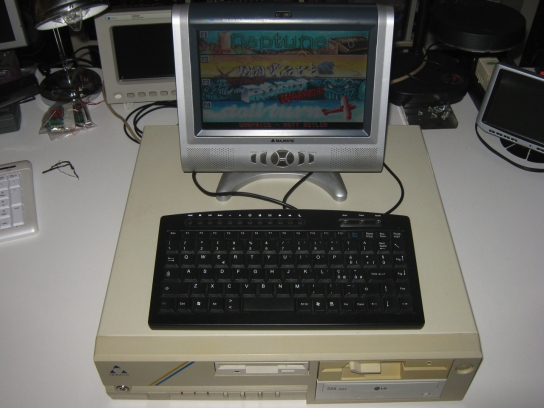
In these days i have had the necessity of a computer with the DOS operating system to create Boot Disk with the ImageDisk program, so i decided to retrieve my old Olidata P133 and install FreeDOS.
I have installed:
- 3COM 3C905 PCI Ethernet Card.
- TCP/IP Stack via 3COM 3C905 Packet Driver.
- Amstrad 1640 5 1/4 Floppy Drive (I had to change a jumper, see photos)
- Upgraded SIMM Ram (100 Mb)
- DOS Driver for Crystal 4232 Sound Card (SoundBlaster Compatible)
- A small fan for the cpu.
- Some Games and Utility.
Gallery:
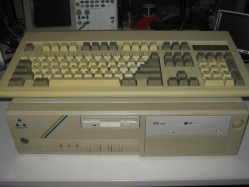
Autopsy:
from Wikipedia:
Olidata is an Italian computer system manufacturer. The company was founded in Cesena, Italy in 1982 by Carlo Rossi and Adolfo Savini as a limited liability company (LLC). Olidata specializes in software development. The company’s accounting software and administrative software divisions were eventually sold to Olivetti.
Olidata is one of the largest manufacturers of computer hardware in Italy. The company also manufactures LCD televisions. In April 2008, Olidata announced the production of its JumPc, a modified version of Intel’s Classmate PC. In 2009, Acer acquired 29.9% of Olidata.
source: wikipedia
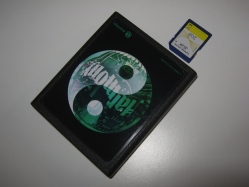
Autopsy:
1 Cents Atari 2600 Video Composite Mod: This very simple/cheap and functional mod adds a Video Composite output to the Atari 2600 console. I have shorted the five contacts Luma/Chroma and Sync for get a decent composite Video Signal. I have also cut a resistor (R55) to get better colors, for the Audio signal see the picture.
The Harmony Cartridge is a simple, affordable, time-saving, space-saving, hassle-free way to play hundreds of games on your Atari 2600 console.
Using a Harmony cartridge is easy. Just insert the Harmony cartridge into your console slot the same way you would with any ordinary Atari game cartridge. Put your favorite game binaries on an SD card, pop it into the Harmony Cartridge and you’re ready to go. Turn on the console, select the game you want to play from the list and start having fun.
source: harmony.atariage.com
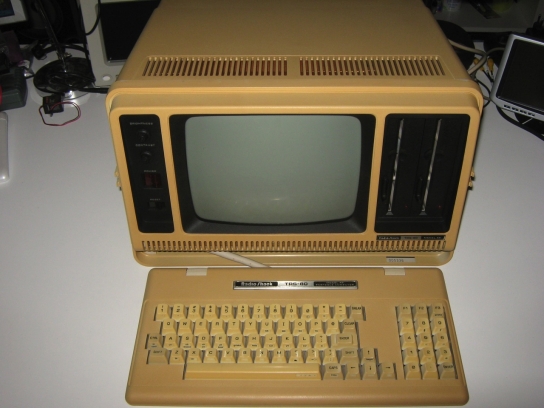
Autopsy:
from Wikipedia:
TRS-80 was Tandy Corporation’s desktop microcomputer model line, sold through Tandy’s Radio Shack stores in the late 1970s and early 1980s. The first units, ordered unseen, were delivered in November 1977, and rolled out to the stores the third week of December. The line won popularity with hobbyists, home users, and small-businesses.
Tandy Corporation’s leading position in what Byte Magazine called the “1977 Trinity” (Apple, Commodore and Tandy) had much to do with Tandy’s retailing the computer through more than 3000 of its Radio Shack (Tandy in Europe) storefronts.
The Model 4 shipped with TRSDOS 6, an enhanced version of LDOS by Logical Systems and a vastly superior operating system to Tandy’s earlier TRSDOS offerings. When the Model 4 booted into TRSDOS 6 the video display switched into 80×24 mode and the entire 64KB address space was mapped as RAM. The Model 4 was also capable of running all Model 3 software when a Model 3 operating system disk was detected and loaded during bootup with a 64×16 video mode and Model 3 ROMs mapped from address zero.
TRS-80 Model 4P.
The Model 4 also had the ability to display 640×240 or 512×192 high-resolution monochrome graphics with an optional board. A “luggable” version known as the Model 4P (1983) was a self-contained unit with a case design similar to that of a portable sewing machine.
Early versions of the Model 4 mainboard were designed to accept a Zilog Z8000 16 bit CPU upgrade board to replace the Z80 8 bit CPU but this option was never released.
source: wikipedia
Today a friend has donated to me some nice things. Thanks Damiano (Manosoft).
Things that have been donated:
- Commodore 2 x C2N.
- Amiga CD32 Games (Rise of the Robots / Brutal Football)
- Super Nintendo/Snes RGB Cable with AV Power Switch.
- Commodore 128 (Only Box)
- Commodore 1571 (Only Box)
- A unopened box of 10 Floppy Disk FujiFilm 5″ 1/4
- Catalog of Jackson 1987-88.
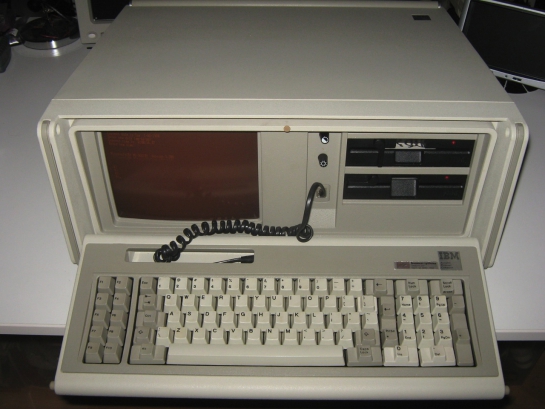
Autopsy:
from Wikipedia:
The IBM Portable Personal Computer 5155 model 68 was an early portable computer developed by IBM after the success of Compaq’s suitcase-size portable machine (the Compaq Portable). It was released in February, 1984, and was eventually replaced by the IBM Convertible.
The Portable was basically a PC/XT motherboard, transplanted into a Compaq-style luggable case. The system featured 256 kibibytes of memory (expandable to 512 KiB), an added CGA card connected to an internal monochrome (amber) composite monitor, and one or two half-height 5.25″ 360K floppy disk drives. Unlike the Compaq Portable, which used a dual-mode monitor and special display card, IBM used a stock CGA board and a composite monitor, which had lower resolution. It could however, display color if connected to an external monitor or television.
The floppy controller card was the same as found in the IBM XT and supported up to four 360K drives (two internal, two external) but was not compatible with the higher-capacity drives then gaining in popularity, notably the 5.25″ quad-density (“1.2MB”) drives that were standard in the IBM AT and 3.5″ 720K drives.
source: wikipedia
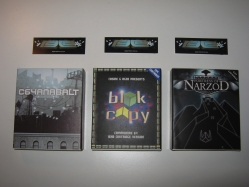
Autopsy:
Today i’m very happy to present three new cartridges for the Commodore 64.
Nowadays, i’m very pleased to see new cartridges for Commodore 64. Many years are gone but this computer doesn’t want to die and honestly i am very happy.
If you like to purchase these fantastic games go here.
source: rgcd.co.uk
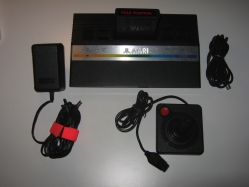
Autopsy:
This version of Atari 2600 console was missing in my collection.
from Wikipedia:
The Atari 2600 is a video game console released in October 1977 by Atari, Inc. It is credited with popularizing the use of microprocessor-based hardware and cartridges containing game code, instead of having non-microprocessor dedicated hardware with all games built in.
The first game console to use this format was the Fairchild Channel F; however, the Atari 2600 receives credit for making the plug-in concept popular among the game-playing public.
The console was originally sold as the Atari VCS, for Video Computer System. Following the release of the Atari 5200, in 1982, the VCS was renamed “Atari 2600″, after the unit’s Atari part number, CX2600. The 2600 was typically bundled with two joystick controllers, a conjoined pair of paddle controllers, and a cartridge game—initially Combat and later Pac-Man.
source: wikipedia
































































































































































































Recent Comments